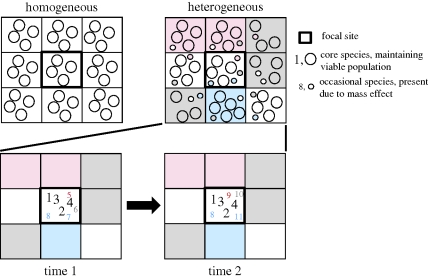Figure 3.
Illustration of the mass effect and its implications for the importance of habitat heterogeneity and the relative difference in temporal turnover among core and occasional species. Grid cells represent habitats with particular environmental conditions (colours) that make them differentially suitable to various species (circles). Any given habitat may support only a limited number of viable populations (large circles, core species), but occasional species (small circles) may also be present in a cell owing to immigration from adjacent cells. Cells occurring in heterogeneous regions with a more diverse regional species pool will therefore include a greater total number of species compared with a cell with similar conditions occurring in a homogeneous region. Because core species by definition have viable populations, there is low temporal turnover in species composition among this group. By contrast, occasional species are constantly colonizing from adjacent habitats and going extinct, resulting in high values of temporal turnover.

